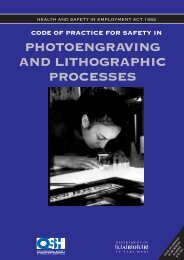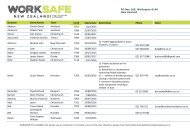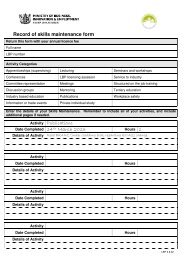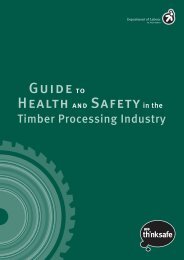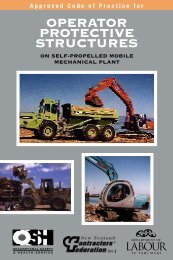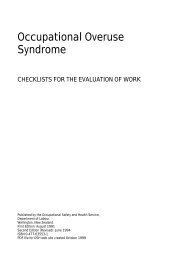Pocket ergonomist industrial/retail [104 KB PDF] - Business.govt.nz
Pocket ergonomist industrial/retail [104 KB PDF] - Business.govt.nz
Pocket ergonomist industrial/retail [104 KB PDF] - Business.govt.nz
You also want an ePaper? Increase the reach of your titles
YUMPU automatically turns print PDFs into web optimized ePapers that Google loves.
The <strong>Pocket</strong> Ergonomist<br />
INDUSTRIAL / RETAIL VERSION<br />
OCCUPATIONAL SAFETY<br />
& HEALTH SERVICE<br />
Reproduced by kind permission of<br />
David A. Brown and Dr Robin Mitchell<br />
Copyright ©1986
WHAT CAUSES FATIGUE?<br />
lf a muscle is kept contracted, or if it contracts repeatedly at<br />
high strength, it can become tired or sore. By reducing this<br />
tension, by introducing micropauses and by performing<br />
workplace exercises to relax and warm up muscles, fatigue<br />
can be minimised.<br />
This guide describes simple, practical methods that we have<br />
used to reduce fatigue, in factories, warehouses and<br />
supermarkets. We trust you will find them just as useful as<br />
we have.<br />
To investigate a report<br />
of an ache, soreness or<br />
weakness, use this index<br />
Neck:<br />
Head posture<br />
or stress Page 5<br />
Shoulders:<br />
Workstation,<br />
workstyle or stress<br />
Pages 4-5<br />
Forearm and hand<br />
(Upper surface):<br />
Page 7<br />
(Lower surface):<br />
Page 8<br />
Back:<br />
Chair work height<br />
or posture<br />
Page 6<br />
Legs:<br />
Loss of circulation<br />
Page 6<br />
David Brown and Robin Mitchell<br />
2
THE STRATEGY<br />
1. Educate employees about the role of tension and posture<br />
in discomfort.<br />
2. Ask each employee to report any discomfort. The OSH<br />
publication Occupational Overuse Syndrome: Checklists<br />
for the Evaluation of Work will simplify this enquiry.<br />
3. Use this <strong>Pocket</strong> Ergonomist to find possible causes and<br />
remedies. Keep trying until the operator reports feeling<br />
better. A Muscle Biofeedback Monitor electromyograph<br />
helps to prioritise the causes of each person’s discomfort. If<br />
one is not available, work through the list and correct all<br />
errors found.<br />
4. Introduce natural relaxation pauses (micropauses) to<br />
interrupt tension. For example, relax one hand, even for a<br />
moment, if only the other is needed.<br />
5. Rotate employees among tasks where possible, if this<br />
varies the muscle load. Take care! Rotation can have social<br />
side effects, e.g. it can be seen as punishment ("he took me<br />
off my favourite job”), or can separate friends.<br />
6. If stress is a problem, ask employees what causes it. Where<br />
possible, change job design (for problems of work rate,<br />
perceived lack of control, or stock build-up) or train<br />
supervisors (for problems of social stress) to eliminate<br />
tension at source. Then establish what the person can do<br />
themselves to stop tension getting out of control, and<br />
practice the solution with them.<br />
7. Demonstrate exercises and supervise their practice.<br />
8. Now ask the employee to summarise the key points of their<br />
new relaxed work methods, and write these down. These<br />
key points should be succinct, for example "drop shoulders;<br />
relax hands in lap when waiting”.<br />
9. Check again within two weeks. If the employee does not<br />
report a substantial improvement, call your occupational<br />
health and safety co-ordinator.<br />
Very important: you (the investigator) should relax too.<br />
3
SHOULDERS AND BETWEEN SHOULDER BLADES<br />
1. Sore on top:<br />
shoulders kept<br />
raised<br />
•<br />
•<br />
•<br />
2. Sore behind top<br />
shoulders kept<br />
pulled back<br />
3. Sore outer shoulder:<br />
elbows kept stuck out<br />
CAUSE OF TENSION<br />
1. Top of shoulder<br />
(a) Work too high<br />
(b) Armrests foul elbows<br />
(c) Chair backrest is too<br />
wide<br />
(d) Untrained worker is tense<br />
(e) Stress<br />
2. Behind shoulder<br />
(a) Same as "Top"<br />
(b) Work too far away<br />
4. Sore between shoulder blades<br />
arms kept forwards;<br />
leaning over; stress<br />
ACTION<br />
Lower bench or equipment, or<br />
raise person (support feet if<br />
seated)<br />
Remove or lower arm rests<br />
300 mm max. Modify/<br />
replace chair or backrest<br />
Train shoulder-elbow work<br />
technique<br />
"Drop shoulders, hang elbows<br />
loose"<br />
Reduce stress at source, e.g.<br />
- self-control of work<br />
pace and flow<br />
- train supervisors to<br />
be positive<br />
Alternate with less stressful<br />
duties<br />
Reduce stress reactions<br />
(relaxation/communications<br />
training)<br />
See 1(a) to (e)<br />
Bring work closer so elbow(s)<br />
hang more vertically (also 6)<br />
4
CAUSE OF TENSION<br />
ACTION<br />
3. Outer shoulder: elbows held out to side<br />
(a) Same as "Top"<br />
See 1(a) to (e) to correct<br />
(Some raise shoulders, others working height, chair height<br />
move elbow)<br />
and backrest, workstyle, stress<br />
(b) Tools or parts too far Reorganise work area to bring<br />
to one side<br />
them closer to midline<br />
so arms hang more vertically<br />
4. Between shoulder blades<br />
(a) Work too far away<br />
Bring work closer so elbow(s)<br />
hang vertically<br />
(b) Employee leans forward to Raise visual task to straighten<br />
see work upper back (see also 6)<br />
(c) Stress<br />
See 1(e)<br />
THE NECK<br />
5. Sore at base of<br />
neck: forward lean<br />
of head<br />
6. Soreness<br />
continues down<br />
back: hunched over work<br />
•<br />
• •<br />
•<br />
7. Sore at top of neck:<br />
chin held up/juts forward<br />
8. Sore one side of neck:<br />
head constantly turned<br />
CAUSE OF TENSION<br />
5. Base of neck:<br />
(a) Visual task too low,<br />
so head stays bent to see work<br />
6. Upper back:<br />
(a) Same as for (5)<br />
(b) Chair too low or high<br />
(especially for writing)<br />
(c) Same as for 2(b)<br />
7. Top of neck:<br />
(a) Visual task too high<br />
(b) Bifocal glasses worn<br />
(c) Stress<br />
ACTION<br />
Raise visual task<br />
Support elbows if necessary to<br />
reduce shoulder load<br />
Raise visual task as above<br />
Adjust chair and educate,<br />
or write with arms supported<br />
Bring work closer<br />
Lower visual task/ rotate staff<br />
Obtain task-specific glasses<br />
Reduce stress, see 1(e)<br />
5
CAUSE OF TENSION<br />
ACTION<br />
8. One side of neck:<br />
(a) Main visual task to one<br />
side<br />
BACK AND LEGS<br />
CAUSE OF TENSION<br />
9. Lower back: (person seated)<br />
(a) Chair backrest too high<br />
or low<br />
Centre the visual task by<br />
moving task or operator<br />
ACTION<br />
Readjust so backrest firmly<br />
supports the "small" of the<br />
back (lumbar region)<br />
(b) Backrest not used<br />
Move backrest forward to<br />
support lower back. If<br />
not possible, modify/ replace<br />
chair<br />
(c) Person slumps forward See 5 and 6<br />
(d) Buttocks not to rear of Move backrest forward, or<br />
chair<br />
educate person to sit back<br />
Lower back (person standing)<br />
(e) Prolonged stooping<br />
(f) Poor standing posture<br />
(sway back)<br />
(g) Lifting overload<br />
•<br />
9. Lower back:<br />
prolonged stooping posture;<br />
poor standing posture; or any<br />
constant back tension •<br />
Raise work or limit time<br />
spent. Exercise!<br />
Exercise to relax back and<br />
tighten stomach<br />
Assess task<br />
10. Lower legs:<br />
Circulation cut off by<br />
chair cushion or lack<br />
of foot movement<br />
10. Lower leg (person seated):<br />
(a) Feet not supported<br />
(b) Chair cushion too deep<br />
(c) Hard front on cushion<br />
Lower leg (person standing):<br />
(d) Lack of movement<br />
6<br />
Provide footrest/ lower<br />
chair and work surface<br />
Replace chair<br />
Replace chair<br />
Alternate jobs; supply easystanding<br />
mats
FOREARM AND HAND (UPPER SURFACE)<br />
11. Sore upper surface:<br />
excessive force; hand or<br />
finger held back<br />
12. Sore outer surface<br />
or elbows:<br />
hand/little finger held •<br />
sideways, or repeatedly jerked<br />
13. Sore hand<br />
(little finger end):<br />
overstretch/ hammering<br />
•<br />
• •<br />
CAUSE OF TENSION<br />
11. Forearm upper surface:<br />
(a) Excessive force used<br />
(heavy force applied,<br />
awkward/inefficient position<br />
used)<br />
(b) Person rests forearm<br />
and stretches hand<br />
(c) Operator bracing wrist<br />
(d) Lack of micropauses or poor<br />
job variety<br />
(e) Stress<br />
12. Outer surface/elbow:<br />
(a) Screwdriver, knife etc.<br />
used forcefully with<br />
bent wrist<br />
(b) Vibrating tool held tight<br />
(c) Elbow(s) held out<br />
(d) Calculator at wrong angle<br />
(e) Wrist is bent to reach items<br />
or controls<br />
13. Hand (little finger end):<br />
(a) Overstretching fingers<br />
(also see 12(c))<br />
(b) "Hammering" action<br />
ACTION<br />
Check tools and improve<br />
where possible; then train<br />
relaxed work technique.<br />
Introduce micropauses and<br />
rotate jobs.<br />
First remedy shoulder load<br />
(see 1); train operator to use<br />
neutral wrist angle<br />
Train relaxed work style<br />
Build in relaxation and<br />
variety; drop hands between<br />
items, etc. See 1(e)<br />
See 1(e) for stress reduction<br />
Change to pistol-grip tools;<br />
redesign job; train in better<br />
technique<br />
Change/modify tool or job<br />
See 1(a) to (e)<br />
Turn calculator to straighten<br />
wrist<br />
Train: "Move hands don't bend<br />
wrist"/reposition work<br />
Use two-hand grip; change<br />
tool handles<br />
Use real hammer, not hand<br />
7
FOREARM AND HAND (PALM SURFACE)<br />
14. Sore flexor muscles:<br />
oversqueezing<br />
15. Sore flexor, outer side:<br />
wrist/ little finger held<br />
sideways<br />
•<br />
16. Sore little finger<br />
overstretch or "banging"<br />
•<br />
• • 17. Sore thumb muscle<br />
sustained pressure<br />
CAUSE OF TENSION<br />
14. Forearm flexor muscles:<br />
(a) Tool requires excessive<br />
grip force<br />
(b) Components do not fit<br />
properly<br />
(c) Small components used or<br />
high precision needed<br />
ACTION<br />
(d) Untrained operator uses<br />
excessive squeezing force<br />
15. Flexors (outer/ ulnar side):<br />
Same as for upper surface See 12<br />
16. Little finger:<br />
(a) Overstretching fingers<br />
(b) "Hammering" action<br />
17. Thumb muscle:<br />
(a) Folding materials using<br />
thumb to crease<br />
(b) Tool uses thumb press<br />
Is the tool faulty? Can the<br />
grip pressure needed be<br />
reduced by a different tool<br />
design?<br />
Call quality control! Inspect<br />
incoming parts; check<br />
previous stages on production<br />
line<br />
Provide easier grip on tools;<br />
provide lead-in on jigs and<br />
mating parts; improve<br />
lighting<br />
Train operator to squeeze less,<br />
e.g use biofeedback<br />
See 13(a)<br />
Use real hammer, not hand<br />
Use back or side of hand/<br />
folding block or blade<br />
Alter to power grip<br />
(c) Writing with awkward<br />
thumb angle<br />
Replace pen/ add rubber<br />
grip/ train writing style<br />
8<br />
P201/5000/1991


![Pocket ergonomist industrial/retail [104 KB PDF] - Business.govt.nz](https://img.yumpu.com/38358958/1/500x640/pocket-ergonomist-industrial-retail-104-kb-pdf-businessgovtnz.jpg)

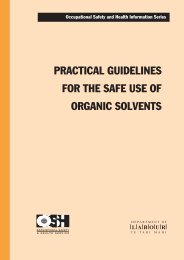
![Task analysis worksheet [161 KB PDF] - Business.govt.nz](https://img.yumpu.com/51400981/1/190x135/task-analysis-worksheet-161-kb-pdf-businessgovtnz.jpg?quality=85)

